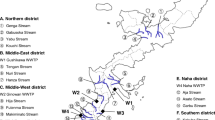Abstract
Extended-spectrum beta-lactamase (ESBL)-producing Enterobacteriaceae are a major public health concern. We previously demonstrated the presence of ESBL-producing Enterobacteriaceae in sachet-packaged water bags sold in Kinshasa, the Democratic Republic of the Congo. In complement to the previous study, we aimed to assess the presence of ESBL-producing Enterobacteriaceae in waste waters in Kinshasa.Enterobacteriaceae isolates recovered from environmental water samples were screened and phenotypically confirmed as ESBL-producers by disk diffusion according to Clinical and Laboratory Standards Institute (CLSI) guidelines (CLSI M100-S21). Final identification to the species level and further antimicrobial susceptibility testing were carried out with MicroScan® NBC42 panels and the identification of bla ESBL coding genes was performed by a commercial multiplex ligation polymerase chain reaction (PCR) microarray (Check-Points CT 101, Wageningen, the Netherlands). Overall, 194 non-duplicate Enterobacteriaceae were recovered from several sewer and river sites in nine out of 24 municipalities of Kinshasa. Fourteen isolates (7.4 %) were confirmed as ESBL-producers, the main species being Enterobacter cloacae (46.6 %) and Klebsiella pneumoniae (40.0 %). Associated resistance to both aminoglycoside and fluoroquinolone antibiotics was observed in ten isolates; the remaining isolates showed co-resistance to either fluoroquinolone (n = 3) or to aminoglycoside (n = 1) alone. All but one isolate carried bla CTX-M genes belonging to the CTX-M-1 group. ESBL-producing Enterobacteriaceae are increasingly being reported from various sources in the community. The present results suggest that ESBL-producing Enterobacteriaceae are widespread in the environment in the community of Kinshasa. Cities in Central Africa should be added to the map of potentially ESBL-contaminated environments and highlight the need to reinforce safe water supply and public sanitation.
Similar content being viewed by others
References
Okeke IN, Laxminarayan R, Bhutta ZA, Duse AG, Jenkins P, O’Brien TF, Pablos-Mendez A, Klugman KP (2005) Antimicrobial resistance in developing countries. Part I: recent trends and current status. Lancet Infect Dis 5:481–493
Vlieghe E, Phoba MF, Tamfun JJ, Jacobs J (2009) Antibiotic resistance among bacterial pathogens in central Africa: a review of the published literature between 1955 and 2008. Int J Antimicrob Agents 34:295–303
De Boeck H, Miwanda B, Lunguya-Metila O, Muyembe-Tamfum J-J, Stobberingh E, Glupczynski Y, Jacobs J (2012) ESBL-positive enterobacteria isolates in drinking water. Emerg Infect Dis 18:1019–1020
Clinical and Laboratory Standards Institute (CLSI) (2011) Performance standards for antimicrobial susceptibility testing; Twenty-first informational supplement. CLSI document M100-S21. CLSI, Wayne, PA
Endimiani A, Hujer AM, Hujer KM, Gatta JA, Schriver AC, Jacobs MR, Rice LB, Bonomo RA (2010) Evaluation of a commercial microarray system for detection of SHV-, TEM-, CTX-M-, and KPC-type beta-lactamase genes in Gram-negative isolates. J Clin Microbiol 48(7):2618–2622
Jouini A, Vinué L, Slama KB, Sáenz Y, Klibi N, Hammami S, Boudabous A, Torres C (2007) Characterization of CTX-M and SHV extended-spectrum beta-lactamases and associated resistance genes in Escherichia coli strains of food samples in Tunisia. J Antimicrob Chemother 60(5):1137–1141
Warren RE, Ensor VM, O’Neill P, Butler V, Taylor J, Nye K, Harvey M, Livermore DM, Woodford N, Hawkey PM (2008) Imported chicken meat as a potential source of quinolone-resistant Escherichia coli producing extended-spectrum beta-lactamases in the UK. J Antimicrob Chemother 61(3):504–508
Abraham WR (2011) Megacities as sources for pathogenic bacteria in rivers and their fate downstream. Int J Microbiol. Article ID 798292. doi:10.1155/2011/798292
Walsh TR, Weeks J, Livermore DM, Toleman MA (2011) Dissemination of NDM-1 positive bacteria in the New Delhi environment and its implications for human health: an environmental point prevalence study. Lancet Infect Dis 11:355–362
Partow H (2011) Water issues in the Democratic Republic of the Congo. Challenges and opportunities. Technical report. United Nations Environment Programme (UNEP). http://postconflict.unep.ch/publications/UNEP_DRC_water.pdf
Funding
This study was sponsored by the Directorate General for Development Cooperation (DGDC) of the Belgian government through the Institutional Collaboration INRB–ITM (IC 2.01). O.L. has a Ph.D. scholarship from the DGDC. The authors declare that they have no conflict of interest.
Author information
Authors and Affiliations
Corresponding author
Rights and permissions
About this article
Cite this article
De Boeck, H., Lunguya, O., Muyembe, JJ. et al. Presence of extended-spectrum beta-lactamase-producing Enterobacteriaceae in waste waters, Kinshasa, the Democratic Republic of the Congo. Eur J Clin Microbiol Infect Dis 31, 3085–3088 (2012). https://doi.org/10.1007/s10096-012-1669-8
Received:
Accepted:
Published:
Issue Date:
DOI: https://doi.org/10.1007/s10096-012-1669-8




